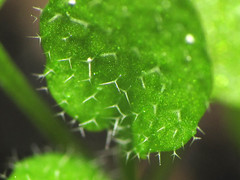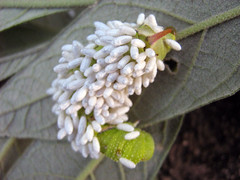 You may be surprised to find that now we're going to talk about the communication systems of plants. Turns out plants can be pretty smart for creatures without brains, nerves, muscles, or specialized sensory organs. When evil herbivores like caterpillars start to munch on plants, plants do not have the option of running away. Instead plants stand their ground with a full arsenal of defenses. Many of these defenses have a direct affect on the herbivore. Direct defenses are things like antifeedants which deter caterpillar feeding, toughening agents that make the plant tissue hard to digest, hairs called trichomes that make the plant tissue spikey and can secrete noxious chemicals, proteinase inhibitors which stymie digestive enzymes in the insect gut, and caterpillar poisons which can kill 'em dead. Direct defenses are the bread-and-butter of plants under herbivore attack. There is another kind of defense, however, called indirect defenses - a way to "call in the cavalry" so to speak.
You may be surprised to find that now we're going to talk about the communication systems of plants. Turns out plants can be pretty smart for creatures without brains, nerves, muscles, or specialized sensory organs. When evil herbivores like caterpillars start to munch on plants, plants do not have the option of running away. Instead plants stand their ground with a full arsenal of defenses. Many of these defenses have a direct affect on the herbivore. Direct defenses are things like antifeedants which deter caterpillar feeding, toughening agents that make the plant tissue hard to digest, hairs called trichomes that make the plant tissue spikey and can secrete noxious chemicals, proteinase inhibitors which stymie digestive enzymes in the insect gut, and caterpillar poisons which can kill 'em dead. Direct defenses are the bread-and-butter of plants under herbivore attack. There is another kind of defense, however, called indirect defenses - a way to "call in the cavalry" so to speak.  Most every insect has an arch-enemy - a parasitoid. Caterpillar parasitoids are usually tiny wasps. When a parasitoid wasp finds its host caterpillar, it will lay its egg(s) in the caterpillar. The parasitoid wasp's eggs develop inside the caterpillar and will eventually, Alien-like, pop out of the caterpillar to pupate and complete their development into adult wasps. This is a pretty painful process for the caterpillar, which is essentially converted into a wasp-incubator and then dies.
Most every insect has an arch-enemy - a parasitoid. Caterpillar parasitoids are usually tiny wasps. When a parasitoid wasp finds its host caterpillar, it will lay its egg(s) in the caterpillar. The parasitoid wasp's eggs develop inside the caterpillar and will eventually, Alien-like, pop out of the caterpillar to pupate and complete their development into adult wasps. This is a pretty painful process for the caterpillar, which is essentially converted into a wasp-incubator and then dies.  You may be wondering how a little wasp finds the right caterpillar. It's a bit like looking for a needle in a haystack, right? If only the haystack would tell you where the needle is hidden! Well, that's essentially what plants do when they activate their indirect defenses. In response to specific compounds called elicitors in the caterpillar's spit, the plant will launch a beacon consisting of a unique blend of odors (usually a blend of terpenes). Parasitoid wasps are attracted to these odors, and come flying to aid the plant by parasitizing the caterpillars trying to catch a meal off the plant. The smell of the beacon is only activated by the caterpillar's spit, and is unique for each species of caterpillar, providing a reliable signal for the parasitoid wasps to find their specific host. The plant-insect communication system really works because the parasitoid wasps are very sensitive to odors and very good at associative learning. They can associate just about any odor or complex odor blend with the stimulus of laying an egg in a caterpillar. Once they've had the experience of finding caterpillar hosts on a plant that smells just so, they will continue to seek out that smell to find more caterpillars. It's a win-win - well, at least for the plant and the wasp.
You may be wondering how a little wasp finds the right caterpillar. It's a bit like looking for a needle in a haystack, right? If only the haystack would tell you where the needle is hidden! Well, that's essentially what plants do when they activate their indirect defenses. In response to specific compounds called elicitors in the caterpillar's spit, the plant will launch a beacon consisting of a unique blend of odors (usually a blend of terpenes). Parasitoid wasps are attracted to these odors, and come flying to aid the plant by parasitizing the caterpillars trying to catch a meal off the plant. The smell of the beacon is only activated by the caterpillar's spit, and is unique for each species of caterpillar, providing a reliable signal for the parasitoid wasps to find their specific host. The plant-insect communication system really works because the parasitoid wasps are very sensitive to odors and very good at associative learning. They can associate just about any odor or complex odor blend with the stimulus of laying an egg in a caterpillar. Once they've had the experience of finding caterpillar hosts on a plant that smells just so, they will continue to seek out that smell to find more caterpillars. It's a win-win - well, at least for the plant and the wasp.So we have a great example of cross-kingdom communication. Why don't plants talk to each other? If you were a tomato plant like one in my garden, crowded up against your neighbors, you couldn't help but 'overhear' when one of your neighbors gets attacked by an herbivore by sensing the parasitoid-calling odor beacon and other compounds that are released when a leaf is damaged. And if your neighbor is being munched, odds are good that you might get munched soon too. Probably should go ahead and load your guns. This is the theory behind priming - that the perception of herbivores feeding on neighboring plants allows undamaged plants to be primed to mount a faster, stronger defense response when the herbivores eventually come for them too. Interestingly, the existence and importance of priming in various plant systems is still in question. For one, plants aren't real cooperative or social creatures, so we don't really expect them to be selected to lend a hand to their neighbors. Also, it is not necessary to assume that just because you can smell the smell of a damaged plant you will certainly be next on the herbivore hit-list. In addition, some have scoffed at the idea of priming just because plants don't typically come equipped with noses with which to sense odors from neighboring plants. Though, is communication dependent on having a mouth and tongue to make words or ears to hear them?
Ichneumonid parasitoid wasp image by Tony Wills [http://www.gnu.org/copyleft/fdl.html], CC-BY-2.5

No comments:
Post a Comment